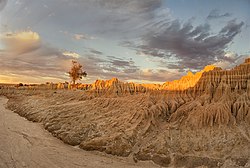Willandra Lake Region
| Willandra Lake Region | |
|---|---|
|
UNESCO world heritage |
|

|
|
|
Wall of China in Mungo National Park |
|
| National territory: |
|
| Type: | Culture / nature |
| Criteria : | (iii) (viii) |
| Surface: | 240,000 ha |
| Reference No .: | 167 |
| UNESCO region : | Asia and Pacific |
| History of enrollment | |
| Enrollment: | 1981 ( session 5 ) |

The Willandra Lakes Region is a UNESCO World Heritage Site spanning 2,400 km² in the Murray River Basin in southwestern New South Wales , Australia . The center of the area is about 70 m above sea level.
The region's climate today is semi-arid. The area is only inhabited by about 40 people, plus several thousand national park visitors annually.
The vegetation consists of scattered shrubs, grassland and woody trees, which are interrupted by sandy areas and dunes. The eucalyptus species Eucalyptus oleosa and Eucalyptus dumosa are the dominant species in the woods, the conifer Callitris columellaris and the porcupine grass Trioda irritans dominate the sandy areas.
About 20 species of mammals live in the region, including red and gray kangaroos, pouch urchins and several species of bats.
It is a fossil lake area from the tertiary era. It consists of marine sediments of lime sand, marl and limestone . In the Quaternary these were covered by sand and dunes. The sand dunes of the region stretch in a straight line in an east-west direction because of the prevailing wind direction at the time. Then they were stabilized by vegetation; in the period from 18,000-16,000 BC They set themselves in motion again for a time.
Today's sand formations in this area can be traced back to the Pleistocene . The climatic effects of the change between ice ages and warm periods on the non-iced areas of the earth can be traced back a long way.
The lakes once formed an interconnected system with a water surface of 1088 km², which was fed by Willandra Billabong Creek, a tributary of the Lachlan River . Sometimes it was only about temporarily water-bearing ponds. By far the largest lake was Lake Garnpung with an area of over 500 km² and a depth of up to 10 m.
The lake system began to dry up with the Prungle lakes 13,000 years ago, the last water-bearing lake was Lake Mulurulu.
Human settlement was archaeologically proven for the area more than 40,000 years ago. These include the cremation Mungo Lady and the burial Mungo Man . In the case of the latter, the body was covered with ocher during the burial , so it is considered the first known "ritual" burial in history. Several rubbing stones used to grind wild grass seeds from around 18,000 BC were found. Well-preserved skeletons of giant marsupials of the megafauna were also found.
Only a small part of the region has been protected by the Mungo National Park since 1979 .
The 2003 film Journey of Man also covers this area.
Web links
- Australian government side to the World Heritage (English)
- Entry on the UNESCO World Heritage Center website ( English and French ).
- UNEP website on Willandra
Coordinates: 34 ° 0 ′ 0 ″ S , 143 ° 0 ′ 0 ″ E
